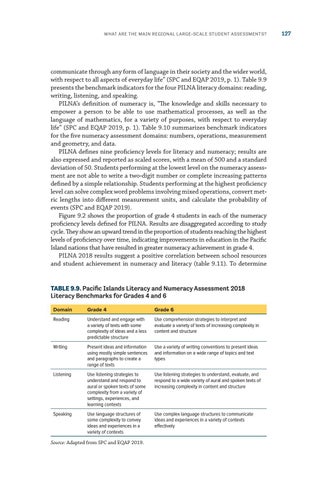What Are the Main Regional Large-Scale Student Assessments?
communicate through any form of language in their society and the wider world, with respect to all aspects of everyday life” (SPC and EQAP 2019, p. 1). Table 9.9 presents the benchmark indicators for the four PILNA literacy domains: reading, writing, listening, and speaking. PILNA’s definition of numeracy is, “The knowledge and skills necessary to empower a person to be able to use mathematical processes, as well as the language of mathematics, for a variety of purposes, with respect to everyday life” (SPC and EQAP 2019, p. 1). Table 9.10 summarizes benchmark indicators for the five numeracy assessment domains: numbers, operations, measurement and geometry, and data. PILNA defines nine proficiency levels for literacy and numeracy; results are also expressed and reported as scaled scores, with a mean of 500 and a standard deviation of 50. Students performing at the lowest level on the numeracy assessment are not able to write a two-digit number or complete increasing patterns defined by a simple relationship. Students performing at the highest proficiency level can solve complex word problems involving mixed operations, convert metric lengths into different measurement units, and calculate the probability of events (SPC and EQAP 2019). Figure 9.2 shows the proportion of grade 4 students in each of the numeracy proficiency levels defined for PILNA. Results are disaggregated according to study cycle. They show an upward trend in the proportion of students reaching the highest levels of proficiency over time, indicating improvements in education in the Pacific Island nations that have resulted in greater numeracy achievement in grade 4. PILNA 2018 results suggest a positive correlation between school resources and student achievement in numeracy and literacy (table 9.11). To determine
TABLE 9.9. Pacific Islands Literacy and Numeracy Assessment 2018 Literacy Benchmarks for Grades 4 and 6 Domain
Grade 4
Grade 6
Reading
Understand and engage with a variety of texts with some complexity of ideas and a less predictable structure
Use comprehension strategies to interpret and evaluate a variety of texts of increasing complexity in content and structure
Writing
Present ideas and information using mostly simple sentences and paragraphs to create a range of texts
Use a variety of writing conventions to present ideas and information on a wide range of topics and text types
Listening
Use listening strategies to understand and respond to aural or spoken texts of some complexity from a variety of settings, experiences, and learning contexts
Use listening strategies to understand, evaluate, and respond to a wide variety of aural and spoken texts of increasing complexity in content and structure
Speaking
Use language structures of some complexity to convey ideas and experiences in a variety of contexts
Use complex language structures to communicate ideas and experiences in a variety of contexts effectively
Source: Adapted from SPC and EQAP 2019.
127

